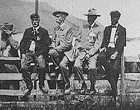Neither the states of the defeated Confederacy nor the former slaves benefitted from this explosion of growth or the Republican-led, business-friendly economic policies. The end of slavery, however overdue, represented the largest uncompensated confiscation of property in history-'property' assigned a market value as high as $4 billion by some economists. The planter class, which before the war had embodied more than 50 percent of the nation's wealth, was in ruins, as were many of the South's major cities. High tariffs worked against the export of the South's primary staple crops-cotton and tobacco-and unsettled labor relations in the wake of emancipation created economic uncertainty throughout the region.
Former slaves proved especially vulnerable. After Andrew Johnson revoked General William T. Sherman's Special Field Orders, No. 15, providing 40 acres to former slaves, the federal government failed to provide any long-term, systemic economic support. The Freedmen's Bureau provided short-term assistance and sought to secure work opportunities for the former slaves, but the widespread opposition of former Confederates rendered the Bureau's efforts largely ineffectual. Those blacks who stayed in the South, and most did for the first fifty years after the war's end, quickly found themselves condemned to poverty by a system of sharecropping. Not until the Great Migration between 1910 and 1930, when over 1.75 million African Americans left the states of the former Confederacy, did blacks begin to break free of a way of life rooted in the 18th- and 19th-century plantation. It took almost a century after the signing of the surrender accords at Appomattox before the South began to match the prosperity of other regions of the nation.
Social and cultural factors exacerbated the regional differences already taking shape as a result of the growing economic disparity. The abrupt end of Reconstruction in 1877 removed federal troops and with it the guarantee of protection for former slaves in the South. In less than two decades, Southern political leaders had constructed the "Jim Crow" regime of racial segregation. In its 1896 Plessy v Ferguson decision, the Supreme Court posited the constitutional doctrine of "separate but equal " in public facilities and accommodations. Although its enforcement varied from state to state, "Jim Crow" came to define social interaction between whites and blacks throughout the former Confederacy as well as several states that had never seceded. It took the combination of the Supreme Court's landmark decision Brown v Board of Education in 1954, the willingness of both the Republican President Eisenhower and the Democrat President Kennedy to deploy federal troops to enforce it, and a series of legislative triumphs by President Johnson in the early 1960s, to put an end this long legacy of inequality.



